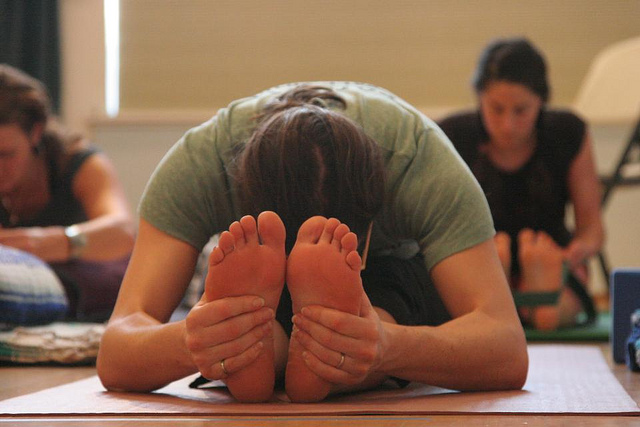Editor’s Note: We lovingly assume zero liability for the choices you make on or off the mat. Be kind to your body!
In this fast-paced world, we tend to accept stress and anxiety as normal.
Job security is relatively low these days. The average work week in the USA is 47 hours. The World Health Organization has declared stress “The health epidemic of the 21st century.” Anxiety and stress are best buddies, and they often appear together.
People have different ways of coping with anxiety and stress. My opinion is that one of the cheapest and most effective ways is yoga.
Let’s explore six simple yoga poses that are known to reduce everyday anxiety.
For most of these poses, you will want to breathe mindfully through the nose.
Extended Puppy Pose
Stretching the spine can bring deep relaxation that reduces anxiety. This pose will gently stretch your spine and shoulders.
Get on all fours in a crawling position. Your hands are under your shoulders, and your knees are under your hips. Bring your hands forward and put your forehead against the floor/mat. Your palms are touching the ground in front of you. Your thighs are vertical. The tops of your feet are on the floor/mat with toes curled. Don’t let your elbows touch the floor. Instead, lift them slightly off the ground and rotate the eyes of your elbows slightly toward each other.
Push your hands into the floor and feel the stretch in the arms. At the same time, pull your butt backward toward your knees. You should feel a big stretch in your whole body. Allow the spine to lengthen.
Hold that pose while breathing deeply through the nose. Allow the back to expand while you breathe, especially the lower back. Breathe into the stretch and embrace the feeling of the stretch with each breath.
Do this for roughly a minute. Then you can lower your butt onto your heels, relax and feel the new sensations in your body.
Child’s Pose Variation (also known as Embryo)
Child’s Pose is an easy pose that relieves tension in the shoulders, neck and back. It’s one of the more common yoga poses for anxiety. Like the Extended Puppy Pose, it loosens the spine. Loosening the spine is one of the keys to deep relaxation.
Get on your hands and knees. Put your knees together. Ease your rear back so that you are sitting on your heels and your forehead is touching the floor. Place your arms by your side so that the tops of your hands are on the ground by your heels.
Breathe deeply through the nose and relax into your pose. Do this pose for a minute or two or whatever feels comfortable.
Seated Forward Bend
It won’t take long to realize that this pose will calm the mind and deepen the breath naturally.
Seated Forward Bends will stretch your legs and your spine, promoting deep relaxation. That is, once you get used to the stretch!
Sit with your legs together on the floor in front of you. Flex the feet and toes so that the toes point upward. Plant your tailbone into the floor and straighten the spine.
While inhaling, extend your arms upward over your head so that you feel a stretch in the spine. While slowly exhaling, bend all the way down so that your face is resting on your legs and your hands are near your feet. Grab your feet.
Your elbows are typically not touching the floor. If you have trouble reaching your feet, you can try putting your elbows on the floor.
You should feel the stretch in all parts of your legs and spine. You’re stretching your spine, not rounding it. Let the shoulders relax away from the ears.
On the inhale, become more aware of your spine. On the exhale, stretch your spine further toward your feet. Breathe deeply through the nose and relax into the stretch each time.
Supported Headstand Against the Wall
Inverted poses send lots of blood and oxygen to the head and brain, and this promotes relaxation.
Kneel down with your feet touching the wall. You’re facing away from the wall.
Put your butt in the air while keeping your forearms on the floor. Stretch your legs out. The only parts of your body touching the floor are the balls and toes of your feet, your forehead and your forearms and hands.
With fingers closed, cup your head with your hands. Left and right fingers are pointing at each other. Your pinkies are touching the floor. This provides support. You can also interlace your fingers.
Put the ball of your right foot on the wall at the same height as your hips. Straighten your right leg as you press the heel into the wall. At the same time, lift your left foot and place the bottom of the foot on the wall.
Your whole body should be vertical except for your legs.
Breathe into the pose through the nose. Keep the breathing as smoothly as possible. Do this for a couple of minutes.
Standing Forward Bend
Half of your body is inverted in this pose, so your head and brain get lots of anxiety-melting oxygen and blood. The pose is also a great spinal stretch, and this further eases anxiety.
Stand with your legs and feet together and your knees slightly bent. Lower your head and torso so that they meet your legs. You should feel this motion coming from your hips. If it’s guided by your lower back, you’re doing it wrong. Don’t round the back while locking the knees. Let your hips and elongating spine be your guides. Place your palms on either your feet or the floor.
Inhale and lengthen your chest and spine. On the exhale, straighten your legs so that you feel a stretch.
After a couple of rounds, exhale and stretch your spine toward the floor with your crown and neck leading the way. Let your shoulders follow. Don’t round your back. Just stretch the spine.
Breathe, through the nose, into the stretch.
Corpse Pose
The Corpse Pose is commonly used at the end of a yoga class. It’s a time to process all the new feelings in the body and to calm the mind.
This one’s easy. Lie on your back with your arms to your side. Breathe through the nose and allow yourself to relax and feel the depth of your experience.
Sources:
Author: Meera Watts
Image: kellinahandbasket/Flickr
Editors: Catherine Monkman; Caitlin Oriel


 Share on bsky
Share on bsky





Read 7 comments and reply